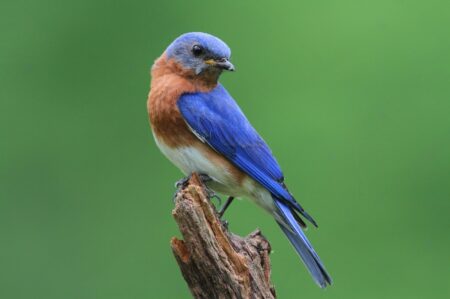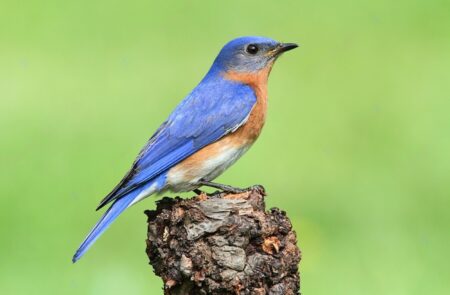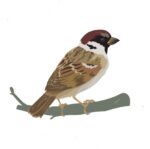How To Attract Bluebirds: A Guide for Pet Lovers
Bluebirds are beautiful and charming birds that are often associated with happiness and good fortune. Many people enjoy watching them in their gardens and backyards, and some even go out of their way to attract them. However, attracting bluebirds can sometimes be a challenge, as they have specific habitat requirements and may face competition from other birds for food and nesting sites.
In this discussion, we will explore some tips and strategies on how to attract bluebirds to your yard or garden. We will cover the essential elements of creating a favorable habitat for bluebirds, such as providing the right food, water, and shelter. We will also discuss how to maintain a safe and healthy environment for these lovely birds.
Whether you are a beginner or an experienced bird enthusiast, this discussion will provide valuable insights and suggestions to help you attract bluebirds to your outdoor space. So let’s dive in and learn more about these delightful creatures and how to make your garden a bluebird haven!
How To Attract Bluebirds: A Guide for Pet Lovers
Bluebirds are some of the most striking and colorful birds that grace our backyards. Their vibrant blue feathers and cheerful songs make them a favorite among bird enthusiasts. If you’re a pet lover, having bluebirds visit your yard can be a source of joy and entertainment for both you and your furry friends. In this guide, we will discuss the steps you can take to attract bluebirds to your backyard and create a bird haven for these beautiful creatures.
- Provide a Suitable Habitat: Bluebirds are cavity nesters and prefer open areas with short grass and scattered trees for foraging. They typically nest in abandoned woodpecker holes, natural cavities, or specially designed nest boxes. To attract bluebirds, you need to provide a suitable habitat for them to thrive. This includes having an open area with short grass, a water source, and scattered trees or perches for them to perch on while keeping an eye out for insects. You can also install a couple of nest boxes made specifically for bluebirds to increase their chances of nesting in your yard.
- Offer the Right Food: Bluebirds are insectivorous, meaning their main diet consists of insects and other invertebrates. Therefore, to attract them to your yard, you need to provide a diverse selection of insects on your lawn. This can be done by avoiding the use of pesticides and planting native plants that attract insects. Another method is to set up a mealworm feeder, which is a bluebird favorite. Mealworms can be purchased at pet stores or bait shops and can be offered in a shallow dish or specialized feeder.
- Provide Clean Water: Bluebirds, like most birds, require clean water for drinking and bathing. A shallow birdbath with a gradual slope is ideal for these birds. The water should be changed and refilled regularly to avoid the risk of disease transmission.
- Keep Cats Indoors: Cats are natural predators of bluebirds, and allowing them to roam freely in your yard can discourage bluebirds from visiting. If you have cats, keep them indoors or supervise them while they are outside.
- Avoid Chemicals: Chemicals from pesticides, herbicides, and fertilizers can be harmful to bluebirds and other birds. It is important to avoid using these chemicals in your yard to create a safe and healthy environment for them.
- Monitor Nest Boxes: If you have installed nest boxes for bluebirds, it is crucial to monitor them regularly. This involves checking for any damage, cleaning out old nests, and removing any potential predators like wasps or squirrels. Keeping the nest boxes clean and safe will increase the chances of bluebirds nesting in them.
- Offer Shelter: During the colder months, bluebirds will appreciate some form of shelter from harsh weather conditions. This can be in the form of a shrub or evergreen tree for them to roost in. You can also provide a roosting box specifically designed for bluebirds.
- Be Patient: Attracting bluebirds to your yard may take some time, and it’s important to be patient. It may take a few weeks or even months for bluebirds to discover and start visiting your yard regularly. However, with the right habitat, food, and safety measures, you will be sure to attract these beautiful birds to your backyard.
What is a Bluebird?
A bluebird is a type of small to medium-sized, brightly-colored bird native to North America. There are several species of bluebird, including the eastern bluebird, western bluebird, and mountain bluebird. They are known for their bright blue feathers on their wings, back, and tail, with rusty or orange-colored chests and bellies. Bluebirds are cavity-nesting birds and can often be found in open woodlands, fields, and pastures, where they feed on insects, fruits, and seeds. They are popular among bird watchers and are also the official state bird of Missouri and New York. Bluebirds are often seen as a symbol of happiness, hope, and good fortune.
SEE ALSO: How To Remove Bird Poop from Car?
How to Attract Bluebirds with A Tuna Can And A Nail
Attracting bluebirds to your backyard can be a rewarding experience. These bright, cheerful birds are known for their distinctive blue color and sweet songs. One way to attract bluebirds to your yard is by setting up a tuna can and nail feeder. This simple DIY project only requires a few materials and can be completed in just a few minutes.
Materials:
- Empty tuna or cat food can
- Nail or small screw
- Wire or string
- Birdseed (bluebirds prefer mealworms, suet, or fruit)
Instructions:
- Clean and dry the empty tuna can. It’s important to use a can that has a pull-tab lid, as this will make it easier to remove the lid and refill the feeder.
- Use a hammer and nail, or a small screw, to punch a hole in the center of the bottom of the can. This will serve as a drainage hole to prevent water from collecting in the can.
- Attach a piece of wire or string to the can by threading it through the hole and tying a knot on the inside of the can. Make sure the wire or string is long enough to hang the feeder from a tree branch or hook.
- Fill the tuna can with birdseed, mealworms, suet, or chopped fruit. Bluebirds are insectivorous and enjoy a variety of foods, so experiment with different options to see what they like best.
- Hang the feeder in a spot that is visible to bluebirds, but also protected from predators. Bluebirds prefer open areas with low vegetation, so a backyard or garden area with some shrubs or bushes nearby would be ideal.
- Monitor the feeder daily and refill as needed. It’s important to keep the feeder clean and well-stocked to attract and retain bluebirds in your yard.
Tips:
- Consider adding a small amount of mealworms, live or dried, to the feeder. Bluebirds are especially fond of mealworms and this can increase the chances of attracting them.
- You can also attach a small dish or saucer to the bottom of the can to hold the food. This will prevent it from spilling out and make it easier for the birds to access.
- If you have trouble attracting bluebirds, try placing the feeder in a different location or offering a variety of foods.
- Avoid using pesticides or herbicides in your yard, as they can be harmful to bluebirds and their food sources.
Plants That Attract Bluebirds
- Berry-producing plants: Bluebirds are primarily insectivores, but they do consume berries during the winter when insects are scarce. Plants that produce small, colorful berries such as juniper, holly, and elderberry can attract bluebirds to your yard.
- Native plants: Bluebirds are attracted to native plants that are adapted to their specific regions and provide food and shelter. Some examples of native plants that attract bluebirds are serviceberry, dogwood, and eastern red cedar.
- Insect-friendly plants: Bluebirds rely heavily on insects for their diet, especially during the breeding season when they need to feed their young. Plants that attract insects such as beetles, caterpillars, and ants can indirectly attract bluebirds.
- Nesting plants: Bluebirds prefer to nest in cavities, such as in old woodpecker holes or nest boxes. Plants that attract woodpeckers, such as oak trees, can also attract bluebirds as they may use their abandoned cavities for nesting.
- Open, grassy areas: Bluebirds are ground foragers, meaning they search for food on the ground. Open, grassy areas provide ample space for bluebirds to hunt for insects and other small invertebrates.
How to Attract Eastern Bluebirds
- Provide suitable nesting locations: Eastern Bluebirds prefer to nest in cavities, such as old woodpecker holes or birdhouses. You can attract them by providing nesting boxes specifically designed for bluebirds. These boxes should be placed at least 100-150 feet apart in an open area with low or sparse vegetation.
- Offer proper food sources: Eastern Bluebirds feed on insects, berries, and fruit. You can attract them to your yard by planting berry-producing bushes and trees, such as dogwood, sumac, or elderberry. Offering live or dried mealworms in a feeder or on a platform can also attract them.
- Create suitable habitat: Eastern Bluebirds prefer open areas with scattered trees and low or sparse vegetation. They are also attracted to areas with plenty of perches, such as fence posts or tree branches. Avoid using pesticides in your yard, as they can harm the birds and their food sources.
- Provide a water source: Like most birds, Eastern Bluebirds need a reliable source of water for drinking and bathing. You can attract them by providing a shallow birdbath or a dripping water feature in your yard.
- Place nesting materials: During the breeding season, Eastern Bluebirds collect nesting materials such as grass, pine needles, and feathers. Placing small bundles of these materials near or on top of your nesting boxes can attract the birds.
- Avoid predators: Eastern Bluebirds are vulnerable to predators such as cats, snakes, and raccoons. To attract them, make sure to place your nesting boxes at a safe distance from trees and offer good visibility for the birds to spot potential predators.
- Be patient: It may take some time for Eastern Bluebirds to find and use your nesting boxes. Be patient and keep providing suitable habitat and food sources, and eventually, they will make your yard their home.
What to Feed A Bluebird
- Insects: Bluebirds are primarily insectivorous and feed on a variety of insects such as grasshoppers, beetles, caterpillars, and spiders. Provide live or dried mealworms, crickets, waxworms, or other insects as a staple food for bluebirds.
- Berries: Bluebirds also love to eat different types of berries, which are rich in nutrients and vitamins. Offer ripe, juicy fruits such as blueberries, raspberries, blackberries, elderberries, and cranberries. You can also plant native berry bushes in your yard to provide a natural and sustainable food source for bluebirds.
- Fruits: Aside from berries, bluebirds also enjoy eating other fruits such as chopped apples, pears, grapes, and raisins. These fruits provide a good source of carbohydrates for bluebirds and can be offered in a dish feeder or scattered on the ground.
- Mealworm suet: Suet is a high-energy food that is made from rendered animal fat and mixed with bird seed, nuts, berries, or mealworms. It can be offered in suet cages or melted and poured into a small dish for bluebirds to enjoy.
Why Attract Bluebirds?
Bluebird families are beneficial for many reasons:
- Pest Control: Bluebirds feed on a variety of insects including grasshoppers, crickets, beetles, and moths. By attracting bluebirds to your yard, you can help control the population of these insects and reduce the need for harmful pesticides.
- Pollination: Bluebirds also feed on a variety of fruits and berries, helping to spread the seeds and promote plant growth.
- Aesthetic Enhancement: Bluebirds are known for their beautiful, vibrant blue coloring, making them a welcome addition to any backyard. Their cheerful songs and playful behaviors are also a joy to watch.
- Conservation: The Eastern bluebird population declined significantly in the 20th century due to habitat loss and competition with non-native species. Attracting bluebirds to your yard can help in their conservation efforts and support a healthier ecosystem.
- Education: By attracting bluebirds to your yard, you and your family can learn more about these fascinating birds and the important role they play in our environment.
- Emotional Well-Being: Studies have shown that watching and interacting with birds can have a positive impact on our mental health and well-being. By attracting bluebirds to your yard, you can enjoy the therapeutic benefits of bird-watching.
- Entertainment: Bluebirds are known for their entertaining behaviors, such as hopping and bobbing while foraging for food. Watching these antics can provide hours of amusement and enjoyment for both adults and children.
SEE ALSO: How Do Birds Survive Winter?
FAQs
Q. What is the best food to attract bluebirds?
A. The best food to attract bluebirds is live mealworms or freeze-dried mealworms.
Q. Where is the best place to put a bluebird house?
A. The best place to put a bluebird house is in an open area with plenty of sunlight, facing towards a tree or shrub line for perching and protection, about 4-6 feet off the ground. It should also be placed away from busy or noisy areas and should have a clear flight path for the birds.
Q. Do bluebirds bring happiness?
A. Some people believe that having bluebirds in their backyard can bring a sense of joy and happiness due to their beauty and sweet songs. However, happiness is subjective, so not everyone may feel this way.
Conclusion
Bluebirds are a beloved sight in many backyard bird enthusiasts’ gardens, with their vibrant blue color and cheerful song. Attracting these beautiful birds to your yard requires some specific steps but can be a rewarding and enjoyable experience. By providing the right habitat, food, and water, you can create an inviting environment that will attract bluebirds and make them feel at home.


